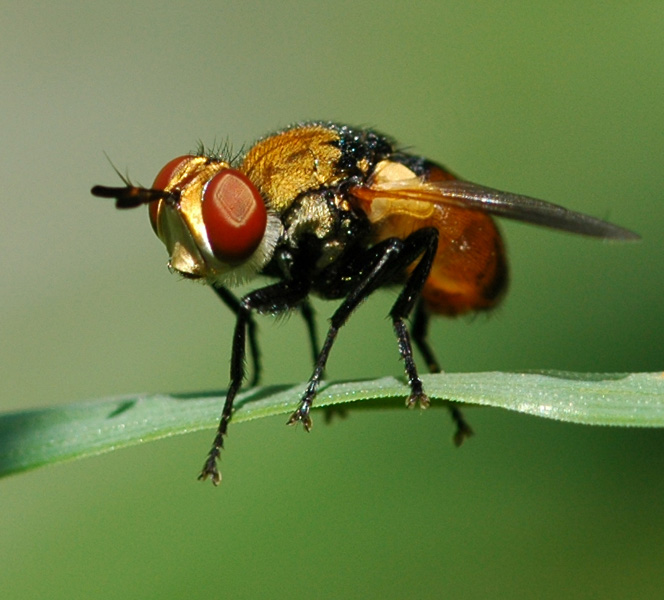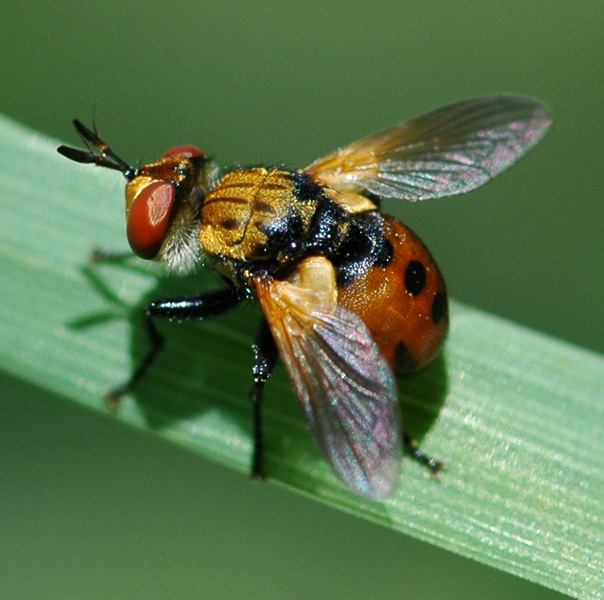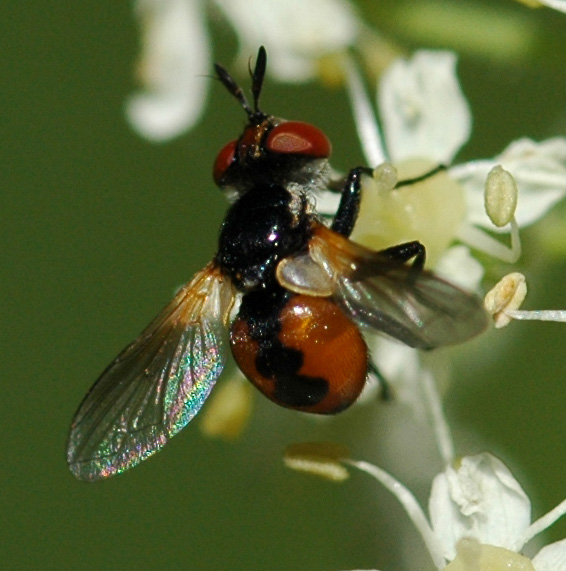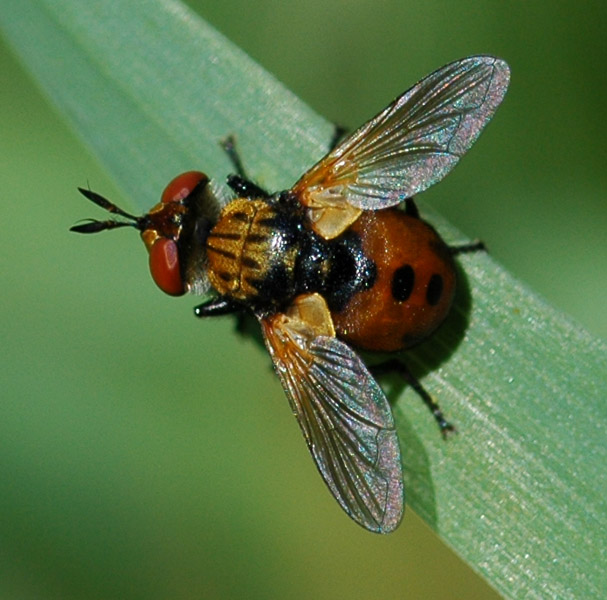Diptera.info :: Identification queries :: Diptera (adults)
|
Swiss Gymnosoma - and some general questions about Tachinidae
|
|
| Cor Zonneveld |
Posted on 24-08-2007 20:54
|
|
Member Location: Amstelveen, the Netherlands Posts: 840 Joined: 14.10.06 |
Two different achinids form Mavaglia, Tessin. Altitude approx 350 m. Grassland with Centaurea and Aster. The fly was looking for possible victims or mates. From a perch, keenly looking for anything on the move, returning to nearly same perch after flying away several times. It looks like Gymnosoma, but is it?
Cor Zonneveld attached the following image:  [124.45Kb] Edited by Cor Zonneveld on 25-08-2007 10:40 Thanks for your attention Cor Zonneveld |
| Cor Zonneveld |
Posted on 24-08-2007 20:54
|
|
Member Location: Amstelveen, the Netherlands Posts: 840 Joined: 14.10.06 |
other angle
Cor Zonneveld attached the following image:  [134.74Kb] Thanks for your attention Cor Zonneveld |
| jorgemotalmeida |
Posted on 24-08-2007 20:55
|
|
Member Location: Viseu - PORTUGAL Posts: 9296 Joined: 05.06.06 |
what about the size?  Do you have dorsal view photos? Do you have dorsal view photos? |
| jorgemotalmeida |
Posted on 24-08-2007 20:57
|
|
Member Location: Viseu - PORTUGAL Posts: 9296 Joined: 05.06.06 |
Yes! It is Gymnosoma sp.  |
| Cor Zonneveld |
Posted on 24-08-2007 20:58
|
|
Member Location: Amstelveen, the Netherlands Posts: 840 Joined: 14.10.06 |
On the same spot, one day earlier, a different species - I guess. Thorax completely black.
Cor Zonneveld attached the following image:  [117.31Kb] Thanks for your attention Cor Zonneveld |
| Cor Zonneveld |
Posted on 24-08-2007 20:59
|
|
Member Location: Amstelveen, the Netherlands Posts: 840 Joined: 14.10.06 |
Size: not a big fly, say 6 - 7 mm. Date: mid July. I'll loke for decent dorsal shot...
Thanks for your attention Cor Zonneveld |
| Cor Zonneveld |
Posted on 24-08-2007 21:03
|
|
Member Location: Amstelveen, the Netherlands Posts: 840 Joined: 14.10.06 |
dorsal view
Cor Zonneveld attached the following image:  [106.89Kb] Thanks for your attention Cor Zonneveld |
| Cor Zonneveld |
Posted on 24-08-2007 21:07
|
|
Member Location: Amstelveen, the Netherlands Posts: 840 Joined: 14.10.06 |
I'm inclined to make a kind of Freudian view of this one...
Cor Zonneveld attached the following image:  [109.61Kb] Thanks for your attention Cor Zonneveld |
| Zeegers |
Posted on 25-08-2007 08:55
|
|
Member Location: Soest, NL Posts: 19209 Joined: 21.07.04 |
The first one is a male G. dolycoridis. The second one not only other species, but also other sex (all female Gymnosoma have black thorax): female G. nudifrons. You may find up to 4 species of Gymnosoma on 1 locality !! Theo |
|
|
|
| Cor Zonneveld |
Posted on 25-08-2007 10:36
|
|
Member Location: Amstelveen, the Netherlands Posts: 840 Joined: 14.10.06 |
Thanks Theo. I looked in the gallery, but find it difficult to see differences between the various Gymnosoma's. What is the basis for the ID in this case? Locality alone? Probably not, since you mention there can be up to 4 Gymno's in a single locality! I also have some more general questions about Tachinidae. Most of them are VERY bristly. I tend to recognize Tachinids on bristles alone... Is there any idea why they are so bristly? Related question: Gymnosoma isn't bristly at all - I guess that's where it got its name from (Gymno = naked, soma = body). So why are some Tachinids not bristly at all?? My personal guess: bristles were present in protoTachinid. They have no function, but do no harm either. In one or more branches of Tachinidae bristles got lost. Once lost, they were lost permanently, since they are functionless. Contra this: bristels cost nutrient and energy, so loosing them offers opportunity for more eggs, very relevant with their life style. Who has any ideas about this? Edited by Cor Zonneveld on 25-08-2007 10:39 Thanks for your attention Cor Zonneveld |
| jorgemotalmeida |
Posted on 25-08-2007 10:55
|
|
Member Location: Viseu - PORTUGAL Posts: 9296 Joined: 05.06.06 |
Usually most tachinids have no petiole (almost Rhinophoridae have this - i think there are very few exceptions.) and they have a very sharp bent in M vein. They have subscutellum (there are indeed some calliphorids with subscutellum to complicate much more !) but this feature is rather hard to see in photos.  And I don?t think that loosing bristles can gives more eggs (human beings loose their hairs and this not affected the descent  ... The bristles could have sensory function, but really I don?t know. ... The bristles could have sensory function, but really I don?t know. |
| Zeegers |
Posted on 25-08-2007 13:09
|
|
Member Location: Soest, NL Posts: 19209 Joined: 21.07.04 |
Right. I suppose the bristles have a sensory function. This makes sense when you are operation in thick vegetation, like canopies for instance. In grasslands, it might be less functional. That's where most of the Phasiinae are found. But I agree instantly, many counterexamples to this simple line of reasoning can be given. Theo |
|
|
|
| Cor Zonneveld |
Posted on 25-08-2007 20:54
|
|
Member Location: Amstelveen, the Netherlands Posts: 840 Joined: 14.10.06 |
Usually most tachinids have no petiole ... etc. That's how to recognize a Tachinid by a key. But on first sight I recognize a Tachinid without noticing any of these features. It's the bristles that count. BTW, my question of recognition concerned the different Gymnosoma's...  And I don?t think that loosing bristles can gives more eggs (human beings loose their hairs and this not affected the descent What I meant was loosing them in an evolutionary sense (I was ambiguous here - my mistake) Like Gymnosoma must have done. Not developing bristles means you can invest in different functions - like reproduction. I suppose the bristles have a sensory function. For reasons of sensory function I suppose the antennae of Tachinids are often oversized (see e.g. Gymnosoma). What use would a bristle be to a Tachinid which is not also useful to a host of different flies that lack the bristles? I guess we just don't know enough about the reasons they have bristles Edited by Cor Zonneveld on 25-08-2007 21:09 Thanks for your attention Cor Zonneveld |
| jorgemotalmeida |
Posted on 25-08-2007 21:26
|
|
Member Location: Viseu - PORTUGAL Posts: 9296 Joined: 05.06.06 |
That's how to recognize a Tachinid by a key. But on first sight I recognize a Tachinid without noticing any of these features. It's the bristles that count. BTW, my question of recognition concerned the different Gymnosoma's...   There are muscids with bristles as well, if I'm not wrong. There are muscids with bristles as well, if I'm not wrong.Concerning Gymnosoma, I still don?t know how we can split them. I know that through photos is not an easy task!  Not loosing them, just not developing them! Like Gymnosoma. Loosing them offers no gain. Not developing them means you can invest in different functions - like reproduction. As far as I know Gymnosoma doesn?t seem to have any special gain for the lack of bristles. For reasons of sensory function I suppose the antennae of Tachinids are often oversized (see e.g. Gymnosoma). What use would a bristle be to a Tachinid which is not also useful to a host of different flies that lack the bristles? I guess we just don't know enough about the reasons they have bristles Perhaps the bristles are very sensitive, and they lack of interest for some habitats... independently of oversized (or not) antennas. For example, to avoid obstacles in a very tick vegetation, it would be helpful to have many and hard bristles.. These are suppositions. Perhaps Theo could tell more.  Really, very interesting questions, keep asking them!  I wish to know the answers. I wish to know the answers.  But even we know those answers, other questions arise again... and again... But even we know those answers, other questions arise again... and again...  |
| Zeegers |
Posted on 26-08-2007 08:24
|
|
Member Location: Soest, NL Posts: 19209 Joined: 21.07.04 |
Antennae are primarily for smelling. So they have little or no tactile function. As for Gymnosoma, the genus badly needs a revision, but noone dares to take on this task. The differences are to be found in the pattern of dusting on thorax and scutellum, as in the male and female genitalia. Tschorsnig & Herting (Tachinidae Mitteleuropas oder so etwas) give a very decent key. Theo |
|
|
|
| Jump to Forum: |













